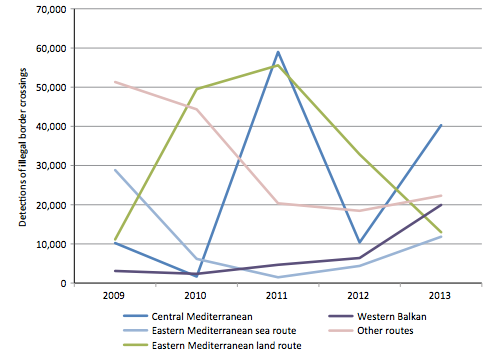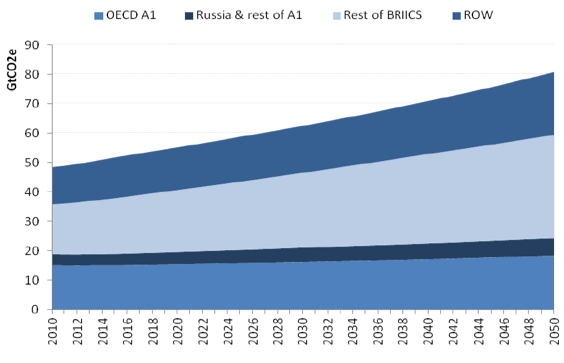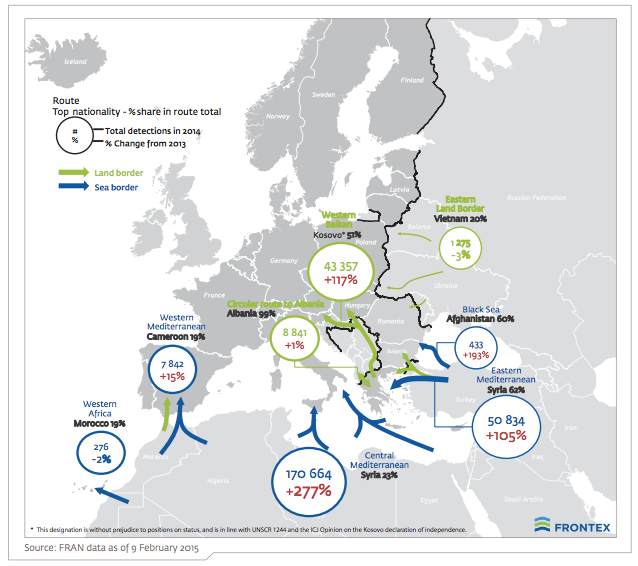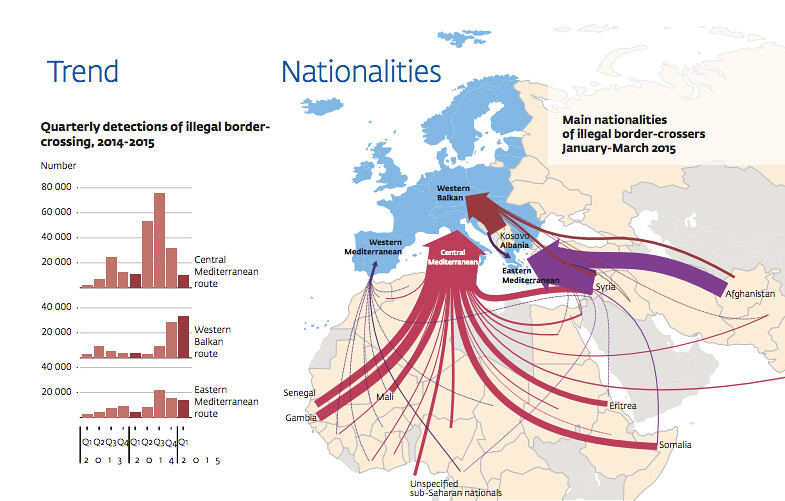The Intensification of the Migration Crisis in the European Union: Between 9/11 and Climate Change

In the wake of the mounting migration crisis in Europe, Global Policy’s General Editor David Held unpacks the reasons behind the upsurge in people crossing the Mediterranean and offers policy responses that suggest the need for both short term and long term actions.
Since the end of the Cold War, migration has taken on a new momentum as patterns of conflict have shifted and intensified with the start of the 9/11 wars. The combination of Western military interventions, ‘anti-terrorism policies’, and increased civil conflict have led to a dramatic rise of migration as a whole, and internally displaced persons (IDPs) in particular – would-be refugees that simply have not yet crossed an international border. Refugees and IDPs are two sides of the same coin, some separated by border fences and some by seas. The European Union has been attempting to follow containment policies – basically seeking to prevent people from migrating. Containment policies exacerbate widespread civil insecurity stemming from failed interventions, civil conflicts, regional collapse, and the widespread threat to human life chances in many areas, particularly the Middle East and North Africa.
These new patterns have been given an additional impetus by the changing nature of environmental degradation. Environmental crises are not, of course, new. For most of human history, the main way in which environmental shocks occurred was via unintentional transportation of flora, fauna, and microbes (Crosby, 1983). The European colonisation of the New World, which shifted diverse forms of natural life across the Atlantic, within a generation all but wiped out a substantial majority of the indigenous population of the Caribbean, Mexico and other parts of Latin America. Until the mid-20th century most forms of environmental degradation, at least the degradation that could be perceived, were local or regional or, occasionally, transregional. However, since the end of Second World War, the globalisation of environmental degradation has been massively accelerated by a number of factors: 70 years of extraordinary resource-intensive growth in the developed world; the industrialisation of Russia, Eastern Europe, and the former Soviet states; the breakneck industrialisation of China and many parts of Asia; and the massive rise in global population.
The result is an unprecedented array of global environmental problems, including climate change, the destruction of rainforests, the loss of biodiversity, and oceanic and riverine pollution. Of these, climate change poses the most severe existential threat. Despite 20 years of multilateral negotiations under the UN, a global deal on climate change mitigation or adaptation remains elusive, with differences between developed countries, which have caused the problem, and developing countries, which will drive future emissions, forming the core barrier to progress (see figure 1). Multilateral governance is gridlocked over climate and, in this context, it is not unreasonable to expect climate change to become an ever more powerful cause of migration (Hale, Held and Young, 2013). Climate change is wreaking havoc on the world’s diverse species, biosystems, and socio-economic fabric. Violent storms are becoming more frequent, water access is becoming a battleground, rising sea levels may well, as predicted, displace millions, the mass movement of desperate people will become more common, and death from serious diseases in the world’s poorest countries will rise rapidly (largely because bacteria will spread more quickly, causing greater contamination of food and water). The overwhelming body of scientific opinion maintains that climate change constitutes a serious threat not only in a long term, but in the here and now.
Figure 1. GHG emissions by region: Baseline, scenario 2010-2050
Note: GtCO2e = Giga tonnes of CO2 equivalent ROW = Rest of the World
Source: OECD Environmental Outlook Baseline, 2012
The term environmental refugee was coined in 1985, and was reinforced in the first 1990 IPCC report which stated that ‘the gravest effects of climate change may be those on human migration as millions will be displaced’ (Intergovernmental Panel on Climate Change 1990, p. 20; see also El-Hinnawi 1985). From 2009 to 2014 approximately 27 million people have been displaced annually as a result of natural disasters, such as flooding, mud-slides, droughts and violent storms (see figure 2). Without an effective policy on climate change, the projections for increasing disaster-affected displacement are dire. According to UNEP by 2060 there could be 50 million ‘environmental refugees’ in Africa alone (Brown 2008). Apocalyptically, Christian Aid in 2007 indicated that close to 1 billion people could be permanently displaced by 2050 with climate change being a key driver in forced migration (ibid).
Figure 2. Impact of extreme weather

Source: Global Call for Climate Change, 2013
The European Union and the Mediterranean migrant crisis: a case study
Migration from North Africa to Europe is certainly not new. For years the Mediterranean has been a thoroughfare for migrants trying to reach the shores of Europe. Whilst migrants have started their journeys from many African and Middle Eastern countries, they are typically bound by a common goal to find greater economic and social opportunities, escape persecution and flee conflict. However, there are notable differences in migration patterns over the last few years.
First, there has been a generalised increase of would-be-migrants attempting to reach Europe. Second, there has been a dramatic rise in the departures that travel via the Central Mediterranean route. In fact, the EU Border Agency, Frontex, estimates that between 2013 and 2014 there was a 277% increase (see figure 3). Third, and bearing in mind UNEP’s projections for environmental refugees in Africa, the push from Africa is only likely to intensify in the future.
Figure 3. Increase in migration flows, 2013-2014
Source: FRAN data in Frontex 2015a
Across the Mediterranean migration is increasing, but nowhere more dramatically than from Libya. From figures 4 and 5, one can see the apparent correlation between migration flows through the Central Mediterranean and the regional instability in North Africa. 2011 was a period of optimism and migration from Libya declined; but it has been exponentially rising since. The majority of the migrants are not Libyan per se. Rather, the greatest number of migrants to date have originated from Syria, Eritrea and Somalia, but there are significant numbers also from Nigeria, Gambia and Mali just to name a few. The instability and chaos that grips Libya has created a vacuum for armed groups, smugglers, gangsters and human traffickers to operate at will; hence, Libya has become the dominant point of departure for many.
Figure 4. Fluctuations in popularity of routes to Europe

Source: Frontex in IOM 2014
Figure 5. Recent trends in and nationalities of illegal border crossovers
Source: Frontex 2015b
The current Mediterranean migration crisis is in many respects a symptom of Western policy failures in two key respects. First, the failed intervention in Libya created the instability that led to the Central Mediterranean route becoming so popular as a passage to Europe. Second, the European countries scaled back recovery efforts just at a time when they were needed the most. From late 2013 to November/December 2014 the Italian government ran a relatively effective operation called Mare Nostrum, during which time more than 100,000 migrants were rescued at sea.
However, the operation was costly at €9 million a month, and Italy cancelled it at the end of 2014 claiming that it was unsustainable without more EU financial backing. In place of Mare Nostrum the EU launched the much-scaled back operation Triton. Under Mare Nostrum the Italian Navy carried out search and rescue operations across 27,000 miles of the Mediterranean. Under Triton, the mandate only covered border surveillance within 30 miles of the Italian coast. The EU budget for Triton was only a third of what was spent on Mare Nostrum. To those who paid attention at the time, this was a huge, bright, waving red flag. Human rights groups and migration experts warned, with virtual consensus, that this would lead to a much larger migration crisis with many more deaths in the Mediterranean.
In the face of renewed crisis (and many deaths) the EU initiated discussions about how to address the Mediterranean migrant dilemma. On the 29th of April 2015 the EU Council released its summary of their 28 country talks. The agenda moving forward can be summarised in three points: confront and prevent smugglers and human traffickers from operating; triple the financial resources for EU border operations including the increase of ships and other necessary capacity; and enhance refugee protection. For the latter, this includes implementing a ‘Common European Asylum System to ensure the same standards in all Member States, an increase of emergency aid to front-line Member States, and the deployment of support teams to help process asylum claims’ (European Council 2015).
This could have gone a long way towards mitigating the escalating tragedy in the Mediterranean. However, it would certainly be a mistake to consider the matter closed and problem solved, even if the EU were able to bring casualties to zero. Upon close inspection of the EU’s plan, it is clear that is has continued to be driven primarily by an exclusionary regional interest to manage and control migration into Europe. These are policies that, whilst having a humanitarian veneer, radically exacerbate the burdens of migrants and displaced persons from and in countries like Libya, Syria, Eritrea, and Somalia. Stefan Kessler captures the underlying motive behind the EU’s new approach: ‘Keep protection-seekers far, far away from Europe so that their deaths don’t make the headlines in European media’ (in Siegfried 2015). Moreover, a conspicuous absence from this response is the increasing concern with climate-induced displacement and migratory flows. Instead, migration continues to be conceived through a security-specific lens, deliberately missing larger parts of the picture. But it is clear that the policy has failed both in its narrow objectives and in wider terms as migration flows put pressure on multiple entry points into Europe, from Macedonia to Italy, Greece to France. Some of these pressures have now become so great that these entry points are almost ungovernable. It remains to be seen how the interplay between state migration policy and actual migratory movements play out, with some countries, notably Germany and Sweden, currently liberalising their border policies, while others, the UK and Hungary for instance, are resisting such moves.
To be sure, these problems are difficult to resolve. The issue of refugees and displaced peoples is one of the great tests of the international humanitarian ideals of the 21st century, and of the cosmopolitan aspirations of a Europe shaped by ambition to project its soft power and good governance across the world. However, when cosmopolitanism meets state interests under economic pressure, the former is often cast aside. Europe, racked by the Euro crisis, has become a partial, and all too often sorrowful, champion of humanitarian values. There is a paradox wherein many European states are cosmopolitan when it comes to championing ideals, but remain sectarian when it comes to their implementation.
Concluding remarks
The growing crisis of migration, as Pierre Hassner once wrote, “like the problem of genocide, or of the environment, or of nuclear proliferation, can be handled only by going beyond the monopoly of states toward a more universal perspective, such as that of human rights, or a more global one, such as that of a collective interest of the planet” (1998, p.281). As Hassner recognised, the question is whether “an effective synthesis of the global and the local, the universal and the particular” remains within the sphere of the possible (ibid.).
Stepping stones to a universal constitutional order, linking the global and the local, are, I have argued elsewhere, already in place, set down by some of the most important achievements of international law and institution building in the 20th century (see Held 2010). These developments generate a conception of rightful authority tied to human rights and democratic values. In this perspective, political power is legitimate, if, and only if, it upholds these standards. Moreover, the link between territory, sovereignty, and rightful authority, is, in principle, broken since rightful authority can be exercised in many spheres and many levels – local, subnational, national and supranational. Accordingly, citizenship can be envisaged, as it already is in the EU, as equal membership in the diverse, overlapping political communities, which uphold common civic political values and standards. Citizenship, accordingly, is not built on exclusive membership in a single community, but on a set of principles and legal arrangements which link people together in diverse communities which significantly affect them.
Stepping stones, yes. But it remains another big step to extend these principles and arrangements to the stateless. Short term extensions policies in the EU could include: centrally funded reception centres; coordinated legal routes through which migrants can travel safely to seek refuge; robust asylum quotas for all member states; tackling human trafficking; and providing direct aid to refugee camps in the Middle East which are currently home to millions of displaced people. Short term working visas and limited working passes are also among options to ease the crises of the stateless while offering universal hospitality in an era of overlapping communities of fate.
Even if this were granted (and we are a long way from this happening), the problem would only be stemmed – not resolved. Only when people live securely in a world where sustainable development is promoted in all regions, where severe inequalities between countries are tempered and reduced, and where a universal constitutional order guarantees the rights of all peoples, could this begin to be envisaged. Cosmopolitan ideals, but still, far from realities.
David Held is a Professor of Political Science and Master of University College, Durham. Among his most recent publications are Globalisation/Anti-Globalisation (2007), Models of Democracy (2006), Global Covenant (2004), Global Transformations: Politics, Economics and Culture (1999), and Democracy and the Global Order: From the Modern State to Cosmopolitan Governance (1995). His main research interests include the study of globalisation, changing forms of democracy and the prospects of regional and global governance. He is a Director of Polity Press, which he co-founded in 1984.
Photo credit: Irish Defence Forces / Foter / CC BY
References
Brown, O. (2008) ‘Climate Change and Displacement: The Numbers Game’. Forced Migration Review, 31. [Online] Available at: <http://www.fmreview.org/FMRpdfs/FMR31/08-09.pdf>. [Accessed May 2015].
Crosby, A. (1983) Ecological Imperialism: The Biological Expansion of Europe 900 – 1900. Cambridge: Cambridge University Press.
El-Hinnawi, E. (1985) ‘Environmental Refugees’, UNEP. Nairobi: United Nations Environmental
Program
European Council (2015) “Report by President Donald Tusk to the European Parliament on the special European Council on migration” [Online] Available at: < http://www.consilium.europa.eu/en/press/press-releases/2015/04/29-report-tusk-european-parliament/>. [Accessed May 2015].
Hale, T. Held, D. Young, K. (2013) Gridlock: Why Global Cooperation is Failing When We Need It Most. Cambridge: Polity Press.
Hassner, P. (1998) ‘Refugees: A Special Case For Cosmopolitan Citizenship?’, in D. Archibugi, D. Held, and M. Kohler (eds), Re-Imagining Political Community. Cambridge: Polity Press.
Held, D. (2010) Cosmopolitanism: Ideals and Realities. Cambridge: Polity Press.
Intergovernmental Panel on Climate Change (IPCC). (1990) ‘Policymakers' summary of the potential impacts of climate change’. Report from Working Group II to IPCC. IPCC: Secretariat, Geneva
Siegfried, K. (2015) ‘The EU’s ‘disappointing’ response to the migration crisis’. [Online] Available at: <http://www.irinnews.org/report/101403/the-eu-s-disappointing-response-to-the-migration-crisis>. [Accessed May 2015].



